How to Create a Bootable Windows 11 USB Installer on a MAC?
For all of its faults, Windows was always known for the fairly easy process of creating an installation media whenever you need to do a clean install or repair install (in-place repair). However, things get complicated when you’re stuck on a macOS device with no access to a Windows Machine.
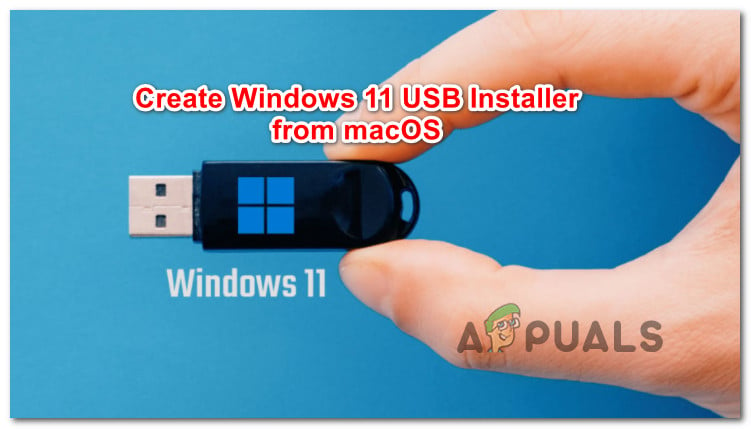
Fortunately, you can still create a bootable Windows 11 USB drive installer from macOS, but you need to either go through some 3rd party software or you’ll need to do some terminal work.
But before we get to the actual methods, you should start by ensuring that the target PC is equipped to meet the minimum requirements to support Windows 11.
Requirements for Upgrading to Windows 11
- 1 GHz or faster CPU with a 64-bit dual-core or multi-core processor.
- 4 GB of RAM and at least 65 GB storage on your system’s disk (we recommend at least 150 GB)
- PC must be equipped with UEFI boot mode support, TPM 2.0, DirectX 13, and WDDM 2.0 driver.
- The connected display must be high-definition (at least 720P) with a diagonal line larger than 8 inches and a color channel of 8 bits.
Now that you are familiar with the requirements, let’s go over the various methods that will allow you to create a Bootable Windows 11 USB on macOS:
- The first option is to use the Terminal app to create the 11 bootable USBs. It works, but the steps get slightly difficult when you get to the part where you need o install a 3rd party tool called wimlib via Homebrew.
- The second option is to use a 3rd party tool called WonderISO. This GUI software will help you create a bootable Windows 11 installer. It’s pretty straightforward as it won’t require you to run any complex commands.
- The third option is to use an open-source tool called Deepin Boot Maker. This tool borrows a lot from the functionality of Rufus, but features a more intuitive interface that is friendly to beginners. The only drawback of this tool is that it won’t allow you to specify a partition scheme, a file system, or set a custom cluster size.
In what follows, we will go through every method described above.
If you want to do this with as little 3rd party interference as possible go for option 1. On the other hand, if you’re looking for an approach as hassle-free as possible, go for option 2 and option 3.
Create a Bootable Windows 11 USB via the Terminal App
First things first, don’t even think of using Boot Camp or a similar approach to get this done. This solution is geared towards dual booting, which is not what we need in our particular scenario.
The better approach is to create a Windows 11 bootable USB using the Terminal app. All the steps outlined below are native (for the most part), with the exception of utilizing a third-party tool called wimlib.
But before proceeding, make sure you meet the following requirements:
- A Windows 11 ISO image file. You can follow the instructions here to get the latest version.
- A Mac computer running macOS. You’ll need version 10.12, 11, or later.
- A USB drive with 16 GB of storage or more.
Once you’ve made sure that you meet every requirement, follow the instructions below to create a Windows 11 Bootable USB from an existing iso on macOS using the Terminal app:
- First things first, go ahead and connect the USB drive to your Mac computer.
- Next, use the launchpad (or the Utilities menu) to open up the Terminal utility.

Opening up the Terminal app - Once you’re inside the Terminal app, your first job would be to find out which of the connected devices is actually your USB stick. To do so, type the following command to list out all the drives currently connected to your Mac:
$ diskutil list
Note: If you’re a windows guy, you should know that Mac shows the USB identifier in a different name Windows.
- Once the results are in, distinguish which is the USB drive you’re planning to turn into a bootable Windows 11 disk by looking at the path and size.
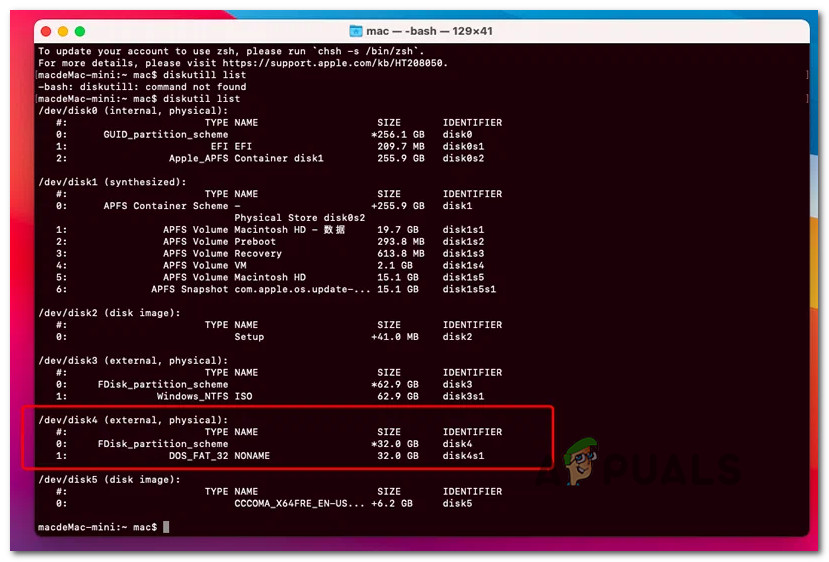
Figuring out which connected device is the USB disk - Next, you’ll need to format the USB drive to FAT 32 in order to facilitate maximum compatibility. Keep in mind that this operation will erase everything, so make sure no sensitive data is stored on the USB drive.
- Initiate the formatting job by running the following command. Make sure to replace the placeholder with the actual name of your USB disk:
$ diskutil eraseDisk MS-DOS WIN11 MBR USBDISK
Note: Keep in mind that USBDISK is simply a placeholder. Before running the command above, replace it with the actual name of your USB drive that you previously fetched at step 4. E.g. /dev/disk3
- Once the drive is successfully formatted, you’ll need to mount the new WIndows 11 ISO image. To do so, type $ hdiutil mount into the Terminal app, then drag the iso to the Terminal app and hit Enter. The end result should look like this:
$ hdiutil mount ~/Downloads/Win11_English_x64.iso
Note: We’re assuming you already downloaded the Windows 11 image (using the instructions in the requirement section above) and you have it stored locally.
- Upon running this command, wait until your macOS successfully mounts this iso image. Once the process is finished, the Terminal app will print the path to the ISO image and volume name. Something like:
/Volumes/CCCOMA_X64FRE_EN-GB_DV9

Copying the volume path Note: Take note of this path as we’ll need it for the next steps.
- Next, we’ll need to copy the files from the Windows 11 mount to the USB drive. Here’s the command that you need to insert:
$ rsync -avh --progress --exclude=sources/install.wim VOLUMESPATH
Note: Keep in mind that VOLUMESPATH is just a placeholder. Replace it with the actual volume path you previously fethed at step 8. The end result should look like this: $ rsync -avh –progress –exclude=sources/install.wim /Volumes/CCCOMA_X64FRE_EN-US_DV9/ /Volumes/WIN11
Getting around the file size restriction
It’s important to note that if you ignore the fact that install.wim is over 4 GB, you will definitely receive the “File too large” error message. This is because FAT32 is a file system that won’t support the handling of files larger than 4 GB (and install.wim exceeds that threshold).
Fortunately, this is not a problem as you can easily use the wimlib tool to split the larger file into 2 pieces in order to complete the moving operation.
For step by step instructions on how to do this, follow the instructions below:
- First things first, you’ll need to install Homebrew on your macOS device. To do so, run the following command on the same Terminal app:
$ /bin/bash -c "$(curl -fsSL https://raw.githubusercontent.com/Homebrew/install/master/install.sh)"
Note: If Homebrew is already installed on your Mac, skip this step altogether.
- Once the installation is complete and you get the success message, restart the Terminal app and type the following command to install the wimlib tool:
$ brew install wimlib
- Finally, go ahead and split the larger install.wim file from the ISO image into two disks by running the following command:
wimlib-imagex split /Volumes//Volumes/CCCOMA_X64FRE_EN-GB_DV9/sources/install.wim /Volumes/W10/sources/install.swm 3000
Note: Make sure to make the necessary adjustments to the volume path so that it matches your particular situation.
- Wait until the files are divided and copied to your USB drive. Depending on your USB writing speed, this might take from a dozen minutes to a full hour.

Wait until the operation is complete - Once the operation is complete and all the files are successfully copied, run this final command to unmount the USB drive and finish the process of creating a bootable Windows drive:
diskutil unmount $DRIVE_MOU
Create a Bootable Windows 11 USB via WonderISO
If the method above seemed too advanced for your competence, don’t worry. You can always use a 3rd party tool that features a simple GUI (WonderISO) to create the Windows 11 Bootable USB installer.
Note: You can use WonderISO to create MBR and UEFI boot options for different computers.
But the prime benefit of using WonderISO is the fact that this tool is capable of automatically splitting the install.wim file into two small pieces automatically. So you don’t have to do it yourself as we did above using the winlib tool.
But before you get too excited, go to the requirements below and make sure you have what you need to g through with this method:
- Windows 11 ISO file. Follow these steps to download the latest version available.
- Mac computer that supports macOS version 10.12, 11 or later.
- A USB flash drive with at least 16 GB of storage
- The Mac version of WonderISO.
Once you’ve ensured that every requirement is met, follow the instructions below for step-by-step instructions on using WonderISO to create a bootable USB drive for Windows 11 on macOS:
- On your macOS computer, open up the App Store and download the latest version of WonderISO for Mac. Additionally, you can simply get the latest available version from the official download page.
- Next, plug in the USB flash drive that you plan on turning into an installation media for Windows 11.
- After you download and install WonderISO on your Mac and plug in the USB, open the application up and click on the Burn tab from the main home screen.
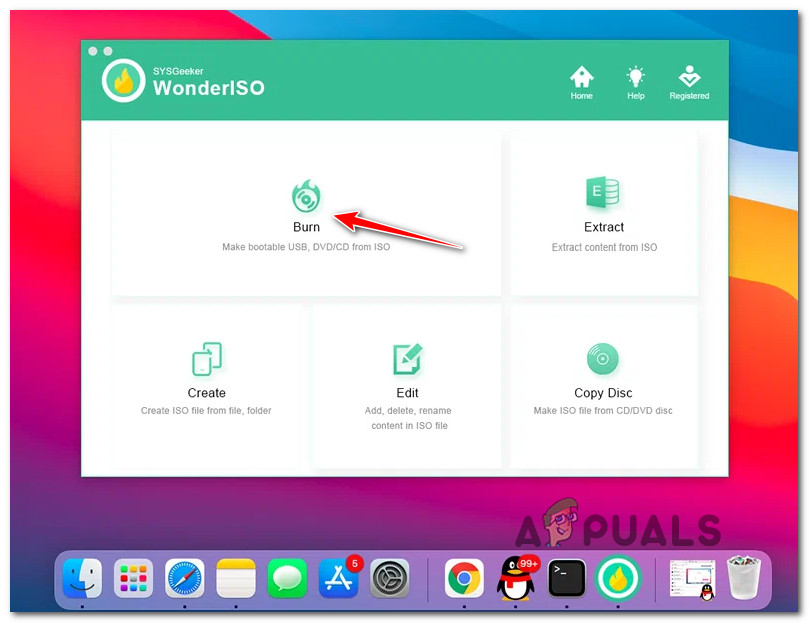
Burning an ISO using WonderISO - From the next screen that appeared, click Browse, then use the next screen to navigate to the path of Windows 11 ISO and select it.
- Next, select the Create a bootable USB toggle, then expand the Partition Style toggle and choose MBR or GPT (depending on which partition style is supported by your Windows PC).
- Finally, look below under System file and change the associated toggle to FAT32 before finally clicking on the Burn button.
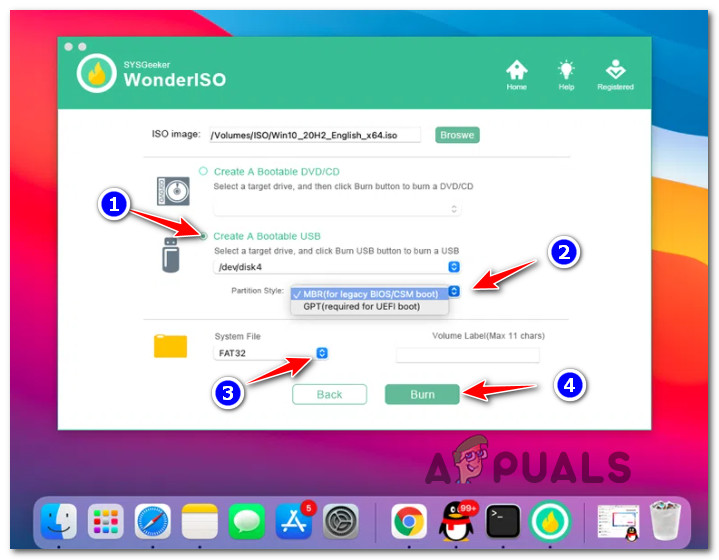
Configuring the WonderISO utility - After you hit Burn and confirm at the confirmation prompt, the utility will begin formatting the USB drive. Wait patiently until the operation is complete. After the drive is formatted to FAT32, the Windows 11 ISO files will be copied over and the drive will be made bootable.

Making the drive bootable Note: At some point during this process, you’ll notice a message saying ‘Process the wim file larger than 4 GB. When you see this message, the utility is actually busy with splitting the larger install.wim file into two files before moving them onto the USB drive.
- Once you get the Burning successfully message, you can safely eject your bootable USB drive and connect it to the PC to install Windows 11 from it.
If you’re looking for a different approach, move down to the next potential fix below.
Create a Bootable Windows 11 USB via Deepin Boot Maker
If you’re looking for the simplest option of the bunch, then definitely go with the Deepin Boot Maker tool. This is an open-source application that will allow you to make a Windows 11 bootable USB from an ISO image with minimal hassle.
However, there are some problems with it. Even though it borrows a lot from the functionality found in RUFUS and features a very simple interface, the success rate for ISO creation is currently less than 40% if you’re on the latest macOS version available.
And just like with the other methods, there are certain requirements that you need to be aware of before going this route:
- Windows 11 ISO image file. Follow this article to get the latest version.
- A USB drive with at least 16 GB of storage.
- The latest version of Deepin Boot Maker.
- macOS version 11 or older. Big Sur (or older) is not supported.
If you don’t mind using a tool that is error-prone and you have time for some experimentation, follow the instructions below to create a bootable Windows 11 USB using Deepin Boot Maker on Mac:
- Visit the official download page of Deepin boot maker and download the latest version available.

Downloading the latest version of Deepin Boot Maker - Once the installation is complete, launch the Deeping Boot Maker utility and click on the … icon. Once you do so, you’ll be presented with a window where you can load the Windows 11 ISO image file.
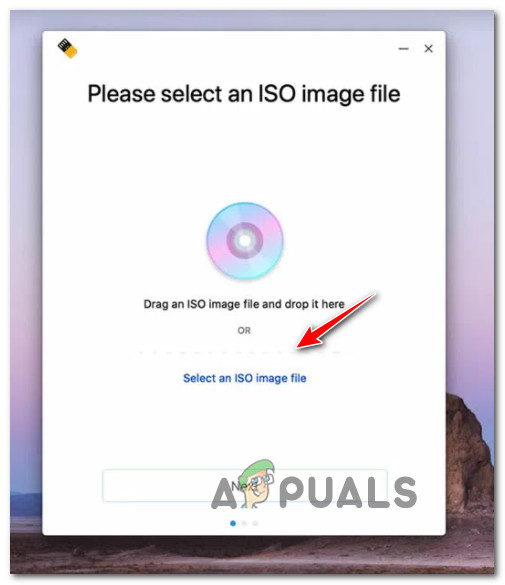
Loading up the ISO file - Next, go ahead and connect the USB flash drive – after a couple of seconds, it should show in the Drive name inside the Deepin Boot Maker window.
Note: If the computer where you’ll install Windows 11 currently uses MBR, check Traditional Mode from the list of options.l - Click on the Burn button to start writing the ISO file.





